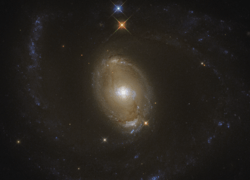NGC 3393
NGC 3393 is a barred spiral galaxy located in the constellation Hydra. It is located at a distance of circa 180 million light years from Earth, which, given its apparent dimensions, means that NGC 3393 is about 140,000 light years across. It was discovered by John Herschel on March 24, 1835.[2] It is a Type II Seyfert galaxy. The galaxy is known to host two supermassive black holes, which are the nearest known pair of supermassive black holes to Earth.[3]
| NGC 3393 | |
|---|---|
 NGC 3393 by Hubble Space Telescope | |
| Observation data (J2000 epoch) | |
| Constellation | Hydra |
| Right ascension | 10h 48m 23.5s[1] |
| Declination | −25° 09′ 43″[1] |
| Redshift | 0.012509 ± 0.000017 [1] |
| Helio radial velocity | 3,750 ± 5 km/s[1] |
| Distance | 181 Mly (56 Mpc)[1] |
| Apparent magnitude (V) | 13.1 |
| Characteristics | |
| Type | (R')SB(s)ab [1] |
| Apparent size (V) | 2′.2 × 2′.0[1] |
| Notable features | Seyfert galaxy Hosts a pair of supermassive black holes |
| Other designations | |
| ESO 501-G100, MCG -04-26-011, AM 1045-245, PGC 32300[1] | |
Characteristics
The galaxy is characterised as a barred spiral galaxy. At both ends of the bar HII regions are present. There is also evidence of a fainter inner bar. The fainter outer arms of the galaxy form a nearly complete ring.[4]
Active galactic nucleus
NGC 3393 has been characterised as a Seyfert galaxy, a galaxy category which features bright point-like nuclei. NGC 3393 is a type II Seyfert galaxy. Its X ray spectrum is more consistent with a Compton-thick cold reflection source, which means that the source is hidden behind dense material, mainly gas and dust, and the X-rays observed have been reflected.[5]
Supermassive black holes
The source of activity in the active galactic nuclei is a supermassive black hole (SMBH) lying at the centre of the galaxy. Observations by the Chandra X-Ray Observatory revealed evidence for a pair of supermassive black holes in the centre of NGC 3393. The observation in hard X-rays, including emission from iron, showed two separate peaks, which were identified as black holes that are actively growing, generating X-ray emission as gas falls towards the black holes and becomes hotter. The obscured regions around both black holes block the copious amounts of optical and ultraviolet light produced by infalling material. They are the first pair of black holes found in a spiral galaxy like our Milky Way. The two black holes are separated by only 490 light years.[3][6]
The two black holes in NGC 3393 are likely the remnant of a merger of two galaxies of unequal mass a billion or more years ago.[6] Other evidence that supports the hypothesis of the galaxy merger include high pre-shock densities in the narrow-line region and low O/H and Mg/H abundances. However the N/H is more than predicted, probably due to the creation of Wolf–Rayet stars in the central region of the galaxy during the merger.[7]
The total mass of the pair is estimated to be between 21 and 35 million M☉.[8]
Supernova
One supernova has been observed in NGC 3393, SN 2018aqi. The supernova was discovered by ASAS-SN on April 6, 2018, and had an apparent magnitude of 16.4 at discovery.[9] By its spectrum, it was identified as a type Ia supernova 6 days before maximum brightness.[10]
Nearby galaxies
NGC 3393 is the brightest galaxy in the NGC 3393 group, which also includes NGC 3369, NGC 3383, and ESO 501-086.[11] NGC 3463 has also been proposed to be a member of the group.[12] The group is part of the Hydra Supercluster.[13]
References
- "NASA/IPAC Extragalactic Database". Results for NGC 3393. Retrieved 2016-01-18.
- NGC 3393 cseligman.com
- "Spiral Galaxy NGC 3393". NASA. 24 November 2015. Retrieved 10 May 2020.
- Alonso‐Herrero, Almudena; Simpson, Chris; Ward, Martin J.; Wilson, Andrew S. (March 1998). "A Near‐Infrared Imaging Study of Seyfert Galaxies with Extended Emission‐Line Regions". The Astrophysical Journal. 495 (1): 196–221. doi:10.1086/305269.
- Maiolino, R.; Salvati, M.; Bassani, L.; Dadina, M.; della Ceca, R.; Matt, G.; Risaliti, G.; Zamorani, G. (October 1998). "Heavy obscuration in X-ray weak AGNs". Astronomy and Astrophysics. 338: 781–794. arXiv:astro-ph/9806055. Bibcode:1998A&A...338..781M.CS1 maint: multiple names: authors list (link)
- Fabbiano, G.; Wang, Junfeng; Elvis, M.; Risaliti, G. (31 August 2011). "A close nuclear black-hole pair in the spiral galaxy NGC 3393". Nature. 477 (7365): 431–434. arXiv:1109.0483. doi:10.1038/nature10364. PMID 21881560.
- Contini, M. (11 September 2012). "Evidence of merging in the Seyfert galaxy NGC 3393, revealed by modelling the spectra". Monthly Notices of the Royal Astronomical Society. 425 (2): 1205–1214. doi:10.1111/j.1365-2966.2012.21504.x.
- Davis, Benjamin L.; Graham, Alister W.; Cameron, Ewan (6 March 2019). "Black Hole Mass Scaling Relations for Spiral Galaxies. I. I. M BH–M *,sph". The Astrophysical Journal. 873 (1): 85. doi:10.3847/1538-4357/aaf3b8. hdl:1959.3/448397.
- "SN 2018aqi". Transient Name Server. wis-tns.weizmann.ac.il.
- "ATel #11516: ePESSTO spectroscopic classification of optical transients". ATel. 8 April 2018.
- Makarov, Dmitry; Karachentsev, Igor (21 April 2011). "Galaxy groups and clouds in the local (z∼ 0.01) Universe". Monthly Notices of the Royal Astronomical Society. 412 (4): 2498–2520. arXiv:1011.6277. Bibcode:2011MNRAS.412.2498M. doi:10.1111/j.1365-2966.2010.18071.x.
- A. Garcia (1993). "General study of group membership. II – Determination of nearby groups". Astronomy and Astrophysics Supplement. 100: 47–90. Bibcode:1993A&AS..100...47G.
- "The Hydra Supercluster". www.atlasoftheuniverse.com.
External links
| Wikimedia Commons has media related to NGC 3393. |
- NGC 3393 on WikiSky: DSS2, SDSS, GALEX, IRAS, Hydrogen α, X-Ray, Astrophoto, Sky Map, Articles and images